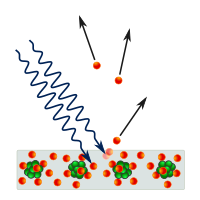photoelectric effect

The photoelectric effect is a strange kind of electrical power that happens when light energy hits certain metals, like aluminum. This energy from the light can make electrons, which are very tiny, invisible parts of an atom, start moving around.
Light energy can act like a wave, but it can also act like little packets of energy called photons. When light energy hits aluminum, the packet of energy breaks off one of the electrons from the atom, and this electron then starts moving around and can be used to create an electrical current.
The really cool thing about the photoelectric effect is that the type of light that can create the electrical current affects how much energy the electrons have, even if the light is really bright. Red light creates electrons with only a tiny bit of energy, whereas blue light creates electrons with much more energy.
Light energy can act like a wave, but it can also act like little packets of energy called photons. When light energy hits aluminum, the packet of energy breaks off one of the electrons from the atom, and this electron then starts moving around and can be used to create an electrical current.
The really cool thing about the photoelectric effect is that the type of light that can create the electrical current affects how much energy the electrons have, even if the light is really bright. Red light creates electrons with only a tiny bit of energy, whereas blue light creates electrons with much more energy.
Related topics others have asked about:
